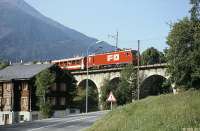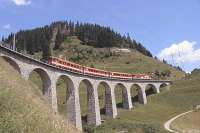
FO

The Furka-Oberalp Railway is the heart of the large alpine narrow gauge network between Engadine and Matterhorn. It connects the valleys of Rhine and Rhone and forms an important east west axis within the Swiss alps. Since 1982 its importance has been increased by the opening of the Furka Basistunnel, which permits an all-season operation.
 After a long and confusing prehistory the "Furkabahn Brig Furka
Disentis" (BFD) was created on May 27th 1910. Financial investors from
France have had a strong influence on the plans. In 1911 the
construction work has started in the Goms (= upper Rhone Valley) and at
the Furka summit section. One year later they started also at the
Oberalp line from Andermatt to Disentis. On June 30th, 1914 the
initialization of the line Brig-Gletsch was celebrated, but the official
acceptance was delayed to the summer 1915.
After a long and confusing prehistory the "Furkabahn Brig Furka
Disentis" (BFD) was created on May 27th 1910. Financial investors from
France have had a strong influence on the plans. In 1911 the
construction work has started in the Goms (= upper Rhone Valley) and at
the Furka summit section. One year later they started also at the
Oberalp line from Andermatt to Disentis. On June 30th, 1914 the
initialization of the line Brig-Gletsch was celebrated, but the official
acceptance was delayed to the summer 1915.
Because of problems at the Furka Scheiteltunnel and the outbreak of the First World War the society came into a financial crisis, which ended in 1923 in a bankruptcy. 1924 a group of interested people under the leadership of the Visp-Zermatt Railway has been formed. Involved were the three concerned cantons Grison, Uri and Wallis, some municipalities and also the neighbour railways Schoellenenbahn and Rhaetian Railway. The rescue and completion of the line has been accomplished by this group. In October 1925 the first train could run over the total distance Brig-Disentis for a test. With the completition of the VZ line Visp-Brig in 1930 the last gap in the large narrow gauge network of VZ, FO, SchB and RhB has been closed. In the same year the famous "Glacier Express" Zermatt- St. Moritz was introduced.
Since the two pass lines were passable only in the summer, a first financial rehabilitation was needed in the thirties. The desired electrification could be carried out only by strong commitment of the Swiss Federation and their military. Starting from summer 1942 the operation on the whole distance was handled electrically. In the same period the Oberalp line was secured for winter operation.
With financial help by the Swiss government the FO merged together with the Schoellenenbahn in 1961. This was a logical consequence of the close operation between both companies.
The old Furka Mountain line has made large problems for the FO for years, because it could be used only in the summer months. In 1970 the planning for a new "Furka-Basistunnel" started. In 1971 the project had passed parliamentary hurdle, in 1973 the construction work started. Geological problems, enormous cost overruns and difficulties with the construction supervision grew up a public scandal, which nearly caused the stopping of all work as a consequence.
 But against all odds the tunnel has been broken through on 2 April 1981
and been put into operation one year later. With a length of 15,381 m
the tunnel was the longest narrow-gauge railway tunnel of the world up
to 1999. In November of that year the Vereina tunnel of the RhB took
over this title with a length of 19.042 m. The old line over the Furka
was shut down in 1981 officially and is operated today by the
Furka Cogwheel Steam Railway.
In 1999 the old line was reconnected to the FO network by a switch in Realp.
But against all odds the tunnel has been broken through on 2 April 1981
and been put into operation one year later. With a length of 15,381 m
the tunnel was the longest narrow-gauge railway tunnel of the world up
to 1999. In November of that year the Vereina tunnel of the RhB took
over this title with a length of 19.042 m. The old line over the Furka
was shut down in 1981 officially and is operated today by the
Furka Cogwheel Steam Railway.
In 1999 the old line was reconnected to the FO network by a switch in Realp.
In October 1998 the network of the FO was extended for the first time since the opening of the Furka-Basistunnel. In order to provide the construction site of the intermediate attack of the Gotthard base tunnel in Sedrun with a track link, a 2 km long connecting line was built. This line branches behind Sedrun station, crosses the Val Bugnei on a 210 m long steel bridge and leads afterwards to the installation place of the construction site. Due to its inclination of up to 7 % the line is equipped continuously with a rack. In order to be able to have sufficient capacities for the materials handling, the line Sedrun-Disentis has been extended. For example the the crossing station Mompe-Tujetsch has been extended and the Disentis tunnel has been rebuilt.
Copyright © 1996
Author: Stefan Dringenberg, last change on 2001-08-21